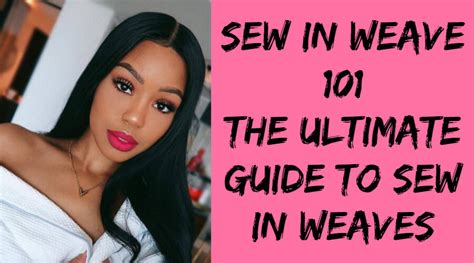Introduction

Weaves, also known as hair extensions, have become an increasingly popular way to enhance one’s appearance. They offer a versatile option for adding volume, length, and style to hair. With a plethora of hair types, textures, and lengths available, finding the perfect weave for your desired look can be an overwhelming task. This comprehensive guide will delve into the world of hair for a weave, providing you with all the information you need to make an informed decision.
Table 1: Types of Hair for a Weave
| Type | Source | Characteristics |
|---|---|---|
| Human Hair | Donated by individuals | Most natural-looking and high-quality; can be styled and colored like your own hair |
| Synthetic Hair | Man-made fibers | Less expensive than human hair; available in a wide range of colors and styles; can be heat-resistant for styling |
| Remy Hair | Human hair with the cuticles intact | Less prone to tangling and matting; provides a smoother, more natural look |
| Virgin Hair | Human hair that has not been chemically processed or dyed | Most expensive type of hair; offers the most natural appearance and can be treated like your own hair |
Choosing the Right Hair for Your Weave
- Determine Your Desired Look: Consider the length, volume, and texture you desire for your weave.
- Consider Your Budget: Human hair is typically more expensive than synthetic hair, but it offers the most natural appearance.
- Match Your Hair Type: Choose a hair type that is similar to your own to ensure a seamless blend.
- Think Long-Term: Virgin hair and Remy hair are more durable and can last longer than other types of hair.
Table 2: Matching Hair Types to Desired Looks
| Desired Look | Recommended Hair Type |
|---|---|
| Natural, Voluminous | Human hair (Remy or Virgin) |
| Bold, Dramatic | Synthetic hair |
| Subtle Enhancement | Human hair (matched to your own hair type) |
Installation Techniques for Hair Weaves
- Sew-In Weave: Hair extensions are sewn onto cornrows at the base of your natural hair.
- Fusion Weave: Hair extensions are attached to small sections of your natural hair using heat.
- Bonded Weave: Hair extensions are attached to your natural hair using a special glue.
- Microbead Weave: Tiny beads are clamped onto sections of your natural hair, and hair extensions are then attached to the beads.
Pros and Cons of Hair Weaves
Pros
- Adds length, volume, and style to hair
- Can transform hair’s texture
- Allows for experimentation with different hairstyles
- May protect natural hair from damage
Cons
- Can be expensive, especially for human hair
- Installation can be time-consuming
- Requires maintenance and care
- May cause damage to natural hair if not installed properly
Table 3: Installation and Maintenance Costs for Hair Weaves
| Installation Method | Cost | Maintenance Cost |
|---|---|---|
| Sew-In Weave | $200-$500 | $50-$100 per month |
| Fusion Weave | $400-$1,000 | $100-$200 per month |
| Bonded Weave | $300-$700 | $75-$150 per month |
| Microbead Weave | $250-$600 | $50-$100 per month |
Caring for Your Hair Weave
- Wash your hair regularly using gentle shampoo and conditioner.
- Avoid heat styling as much as possible.
- Use a detangling brush or wide-toothed comb.
- Get regular trims to remove split ends.
- Deep condition your weave every 2-3 weeks to keep it moisturized.
Table 4: Troubleshooting Common Hair Weave Problems
| Problem | Solution |
|---|---|
| Tangling | Use a detangling brush or wide-toothed comb |
| Shedding | Get regular trims and avoid over-brushing |
| Hair breakage | Avoid excessive heat styling and use a deep conditioner |
| Weave slipping | Visit your stylist to have it retightened or reinstalled |
| Scalp irritation | Use a gentle shampoo and conditioner, and avoid tight braiding |
Frequently Asked Questions About Hair Weaves
- Is my hair too short for a weave? It depends on the installation method. Fusion and bonded weaves require a certain length of natural hair to attach to.
- Can I dye my hair weave? Human hair weaves can be dyed, but it’s best to have it done by a professional stylist to avoid damage.
- How long does a hair weave last? The lifespan of a weave depends on the type of hair, installation method, and maintenance routine. Generally, weaves can last for 3-8 months.
- Can I swim with a hair weave? Yes, but it’s important to wear a swim cap to protect the weave from chlorine and salt water.
Innovative Applications for Hair Weaves
- Color Streaks: Create vibrant streaks of color by weaving in different colored hair extensions.
- Ombre Weave: Achieve a gradual transition of color by weaving in hair extensions that are darker at the roots and lighter at the tips.
- Lace Front Weave: Provide a more natural hairline by using a lace front wig as the base for your weave.
- Dreadlock Weave: Create faux dreadlocks by weaving in extensions made from synthetic dreadlock hair.
Conclusion
Hair weaves offer a plethora of options for enhancing your appearance and experimenting with different hairstyles. By understanding the different types of hair available, choosing the right installation method, and following proper care and maintenance practices, you can enjoy a beautiful and long-lasting hair weave. Remember to consult with a professional stylist to get personalized advice and ensure the best results for your individual needs.
